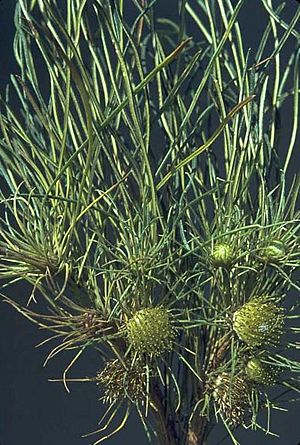Awled honeypot facts for kids
Quick facts for kids Awled honeypot |
|
|---|---|
 |
|
| Conservation status | |
| Scientific classification | |
| Genus: |
Banksia
|
| Species: |
subulata
|
| Synonyms | |
|
Dryandra subulata C.A.Gardner |
|
The Banksia subulata, also known as the awled honeypot, is a special kind of plant. It's a low-growing, bushy shrub that only grows naturally in the southwest part of Western Australia. It has long, thin leaves that curl under at the edges. Its flowers are yellowish-green and grow in clusters. After flowering, it produces round, seed-holding pods called follicles.
What Does It Look Like?
The Banksia subulata is a bushy shrub that grows low to the ground. It usually spreads out to about 0.5 meters wide. This plant does not have a special woody swelling at its base called a lignotuber, which helps some plants regrow after a fire.
Its leaves are long and thin, like lines. They can be from 150 to 350 millimeters (about 6 to 14 inches) long and about 2 to 2.5 millimeters wide. The edges of the leaves are usually curled under. Each leaf sits on a very short stalk, called a petiole, which is only about 1 millimeter long.
The flowers are yellowish-green and grow in groups called "heads." Each head has about 65 to 75 individual flowers. At the base of these flower heads, there are many leaf-like parts called bracts. Some of these bracts are long and thin, like an awl (a pointed tool), measuring 30 to 80 millimeters. Others are shaped like a spearhead and are about 10 to 12 millimeters long.
The flower's outer part, called the perianth, is 22 to 24 millimeters long. The female part of the flower, called the pistil, is also 22 to 24 millimeters long. This plant usually flowers from September to October. After the flowers, it produces round, almost spherical seed pods called follicles, which are about 11 millimeters wide.
How It Got Its Name
This plant was first described in 1964 by a botanist named Charles Gardner. He found specimens of it near the Hill River and named it Dryandra subulata. He published his findings in the Journal of the Royal Society of Western Australia.
Later, in 1996, another botanist named Alex George noticed that this species was quite unique. It had long, smooth leaves, stiff, awl-shaped floral leaves, and round seed pods. Because it didn't seem closely related to other plants, he placed it in its own special group called Dryandra ser. Subulatae.
More recently, scientists like Austin Mast and Kevin Thiele have been studying the DNA of plants in the Banksia and Dryandra groups. Their research showed that Dryandra plants actually fit inside the Banksia group. So, in 2007, they decided to combine Dryandra into Banksia. This meant that Dryandra subulata was officially renamed Banksia subulata.
Where It Lives
The Banksia subulata grows in a type of low shrubland called kwongan. You can find it in the area between Eneabba and the Hill River in Western Australia.
Its Conservation Status
The Government of Western Australia's Department of Parks and Wildlife has classified this banksia as "Priority Three". This means that we don't know a lot about this plant, and it's only found in a few places. However, it's not currently in immediate danger of disappearing.


